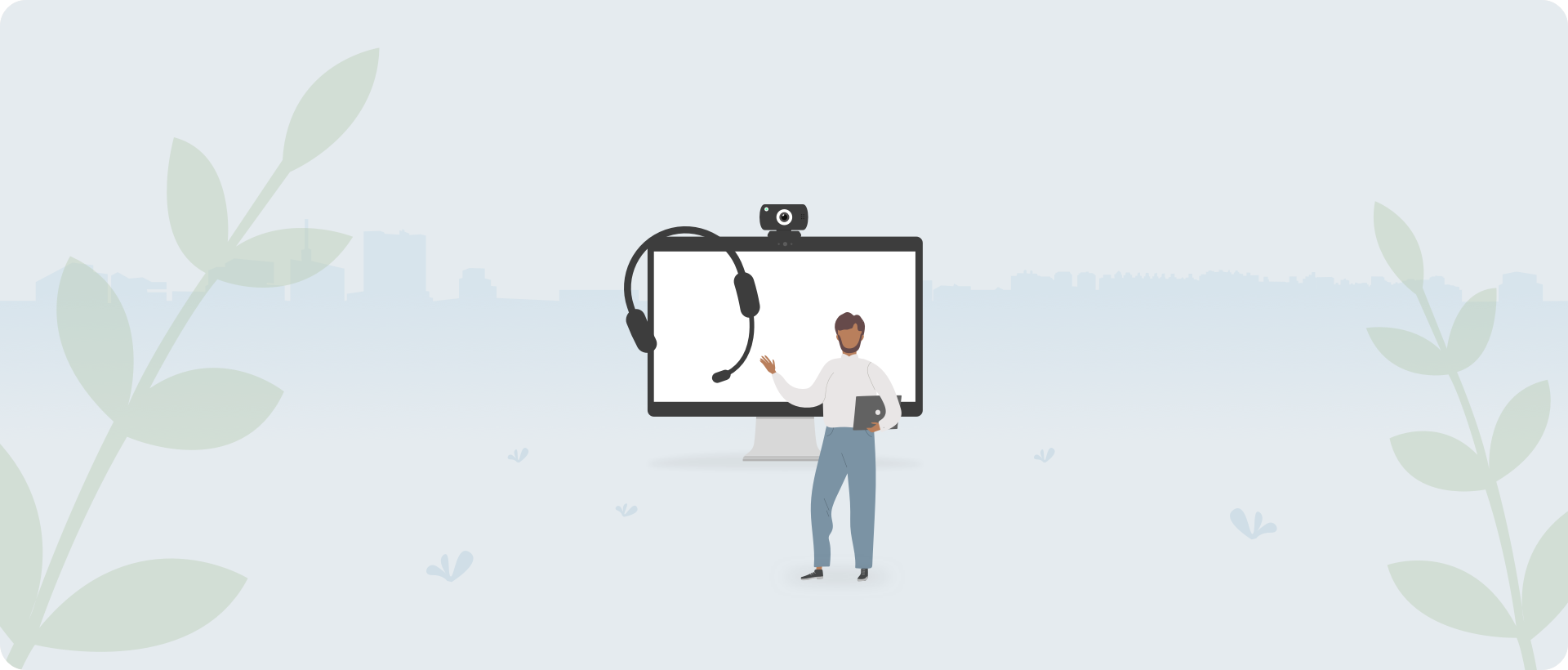Deloitte’s 2023 Global Contact Center Survey found that 63% of contact center leaders face staffing shortages. In addition to increasing hiring costs, this also puts increased pressure on retaining agents who have the customer service attributes to be a good customer service representative.
What’s more, NICE’s 2022 contact center survey found that the average contact center attrition rate for in 2021 was 42%, in the region of the pre-pandemic numbers.
Bigger companies were more affected by the Great Resignation than smaller ones, and BPOs were more impacted than contact centers. The survey found that organizations with up to 1,000 agents experienced a 34% attrition rate, while BPOs with 5,000 agents or more saw the number growing to 50% during the pandemic.
On top of this, the report showed that 31% of customer service agents are actively looking for a job.

Coupled with the fact that top talent is only on the market for 10 days, and the average time to hire for BPOs is 25 days, it becomes quite obvious that contact centers and BPOs need to accelerate their hiring if they want to attract the good candidates.
But the problem with speeding up the volume recruitment process is that it tends to have a knock on effect further down the line: for example, hiring fast while disregarding quality of hire leads to higher costs per hire in the long run, because turnover increases, early employee attrition increases, productivity decreases, etc.
So how can you speed up the volume hiring process for BPO positions while ensuring quality of hire remains high and employee turnover is low?
The short answer is: By investing in technology that does the manual work for you, freeing up your recruiters to do what they do best – hire quality candidates. But before we delve into how to speed volume hiring up, let’s take a look at what both candidates and recruiters expect from the BPO recruitment experience.
What’s in?
What candidates expect from the application process
When it comes to the application experience, candidate expectations are constantly evolving as the workplace changes. In general, today’s job seekers expect:
- A clear understanding of the role. The biggest driver for early attrition from new employees is misaligned expectations. Candidates therefore not only expect, but deserve recruiters to be clear about the role in question in the job description. They want to know, upfront, what the role entails, what the main responsibilities are, how well suited they are for the role, and remuneration expectations.
- A quick, mobile-first application process. Appcast’s 2021 Recruitment Marketing Benchmark report looked at job advert data from 1300 employers across the US, and found that in the last three years, 60.7% applications were submitted from a mobile, and only 39.9% came from a desktop.
- Quick communication. The majority of the current workforce are digital natives, as such, they expect the rest of the workforce to be as well. Meaning they expect to receive timely responses and quick communications from employers. According to a DaXtra survey, 34% of candidates expect to hear back from hiring managers within 24 hours of applying.
Like what you see?
Don’t miss out. Subscribe to our quarterly digest to get the latest TA and TM resources delivered right to your inbox.
What the ideal process looks like for recruiters
In an ideal world, recruiters hiring for BPOs aren’t stuck under a barrage of manual tasks. They aren’t repeatedly scheduling interviews, nor are they manually screening applicants.
Instead, they’re using tools that are purpose-built for volume hiring and can speed up the recruitment process without affecting quality of hire or the candidate experience. Such technology should support them in their role and integrate seamlessly with their existing tech stack, enhancing their recruitment capability.
The ultimate volume hiring process is digital-first, fast, efficient, and bias free. It leverages a strong employer brand to source top talent at one end, which results in hiring the best candidates at the other end. And when applicants enter the funnel, there is technology in place to accurately and efficiently identify the top candidates and progress the best of them through a process that flows seamlessly, including:
- Automated, data-driven sourcing
- Automated assessments for screening the ideal customer service qualities
- Data-driven, automated selection decision using matching technology
- Automated interview scheduling
- Asynchronous recorded interviews or short synchronous interviewing
- Automated background checking
All of which happens in a timely manner, with limited human input required except for the in-person interview and when a hiring decision has to be made.
Common bottlenecks in BPO & contact center volume hiring
To reach the ideal state described above, BPOs and contact centers need to first look at their current practices and identify the bottlenecks and areas for improvement.
- Manual processes. When repetitive tasks such as scheduling interviews and candidate screening falls to recruiters, everything slows down as recruiters have to take action to progress applicants along the hiring process to the next step. And if the volume of candidates is high, a bottleneck forms.
- Using regular tools to hire at scale. Trying to hire at scale using tools that are designed for regular recruitment won’t cut it. If they don’t integrate with the existing tech stack, it can result in TA teams relying on several tools to collect and process candidate data, leading to multiple ‘sources of truth’. In the long run, this creates bottlenecks, as recruiters have to switch between the various platforms to check assessment results, review applicant profiles, etc.
- Lack of structured data. A fragmented hiring process that incorporates multiple platforms and tools is often linked to a lack of clarity when it comes to data collection and analysis. Without proper data to back up their decisions, it’s almost impossible for talent teams to know what levers to pull to streamline their operations.
- Unmanageable recruiter workload. If there aren’t enough recruiters to handle the manual processes, the increased workload on existing recruiters can cause them to burnout and eventually churn. This results in delays throughout the entire hiring process.
- Long time to hire. Time to hire is another big challenge. With an average TTH of 25 days, when every contact center is on a recruitment drive currently, you’ll lose the top talent in your pipeline to competition. And that’s because candidates lose interest in a job when faced with lengthy processes.
- Hardware and software setup of remote workers. Contact centers and BPOs need to ensure their remote workers are capable of doing the job and have sufficient hardware and software to do the job justice. Recruiters can use online system diagnostic tools to see if candidates’ equipment is sufficient.
While these aren’t the only challenges recruiters face when hiring for entry-level roles in BPOs and contact centers, all these issues combined lead to unnecessarily complex, lengthy, and inefficient processes.
- White paper
Before you continue!
Don’t forget to grab your free copy of our white paper on contact center volume hiring in 2021. Learn about:
- The challenges currently shaping the contact e
center recruitment space - How employers can navigate the new remote-first reality, and the role of technology in a future-proof recruitment process
- The four building blocks of a fully digital recruitment process
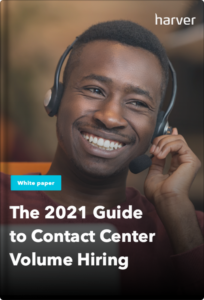
Prerequisites for automating the recruitment process
Now that we’ve explored what the ideal hiring process looks like and some of the common bottlenecks in the recruitment process, let’s turn our attention to how to speed the volume hiring process up for your BPO or contact center.
1. Map your hiring journey
When you’re operating at scale, and you’re trying to speed the volume hiring process up, you can’t afford inefficiencies in the flow. But when you introduce tech stacks into the equation that require the hiring team to use different tools that aren’t always integrated, it can get messy quickly.
Map out your entire hiring journey including the steps and the touchpoints along the way, the tools that you use, the data you collect and the communication that you send to applicants. This will give you the big picture before you begin redesigning your hiring process.

It will help you improve your recruitment strategy as well as help you identify any weak spots along the journey, the bottlenecks and the gaps. Moreover, it allows you to see the process from the candidate’s side, what your employer brand looks like, as well as highlight where you can speed up the process for both the recruiting team and candidates.
2. Identify the candidate touchpoints
To speed up your volume hiring process, you need to identify the multiple touch points along the hiring journey that candidates will hit. Things such as your job postings, your social media, your career site, job boards, submitting an application, sitting your pre-employment assessments, scheduling an interview, taking part in the interview process.
All of these touchpoints play a role in helping the candidate decide whether or not they want to come and work for you. Identifying them will help you establish where the bottlenecks are, if any, from the candidate side. Doing this will help improve candidate experience as well as speed the process up, once you release the bottleneck.
3. Decide which steps can be automated
If you’re still relying on outdated, manual hiring processes, it can be overwhelming to automate fully. But by utilizing volume hiring technology to streamline the process, you’ll automate repetitive tasks, freeing you up to hire better and faster.
Once you’ve mapped out your candidate journey, you’ll be able to identify which steps in your process can be automated.
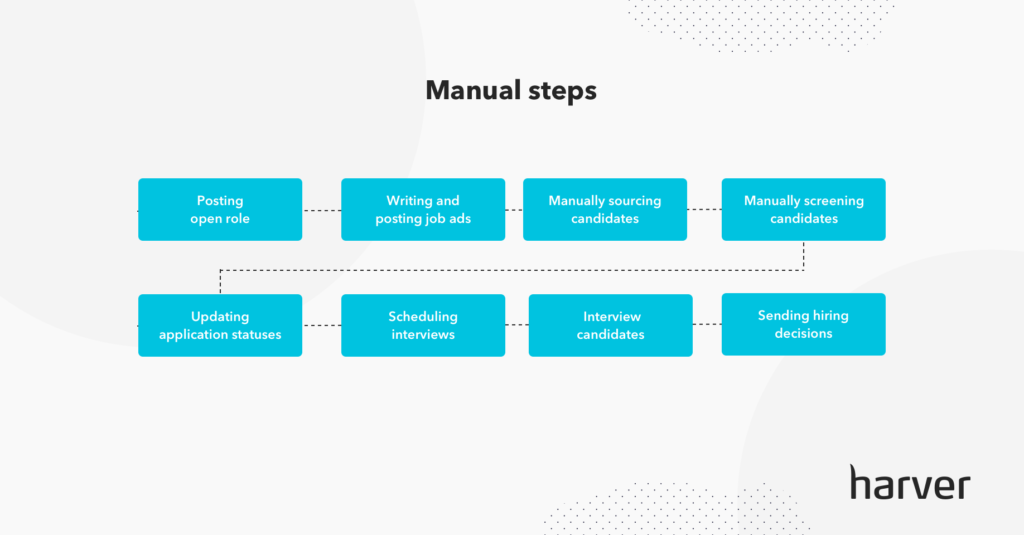
Hint – every single one of them can, except where you need a human to interview or to make a hiring decision. Everything else can be done automatically, on autopilot.
4. Design the hiring process
You want an application process that is as smooth for recruiters as it is for the candidates going through it. Your recruiters are after all, the ones who will be doing the heavy lifting for you. You want to design an application process that will allow them to be as productive as possible, which in turn will help speed up the volume hiring process.
5. Create a data strategy to ensure visibility
Review your existing tech stack. Evaluate your entire recruitment process from end to end from a technology point of view. How is your tech integrated and how does it help speed up your workflow?
Once you know this, you’ll not only be able to simplify your existing tech stack, but you can streamline your data collection process and design a data strategy that ensures you have complete visibility of all your recruitment metrics.
6. Ensure proper integrations throughout your tech stack
The next step is to make sure you’re leveraging the data to your advantage. You’re collecting so much business intelligence data, take advantage of it by analyzing it and feed the results back into your system to optimize it further.
When you’re reviewing your tech stack, make sure you check what recruitment KPIs you’re tracking, as well as what data you’re collecting, how the data is being collected and how you’re analyzing it, and finally how all of your tech solutions are integrated.
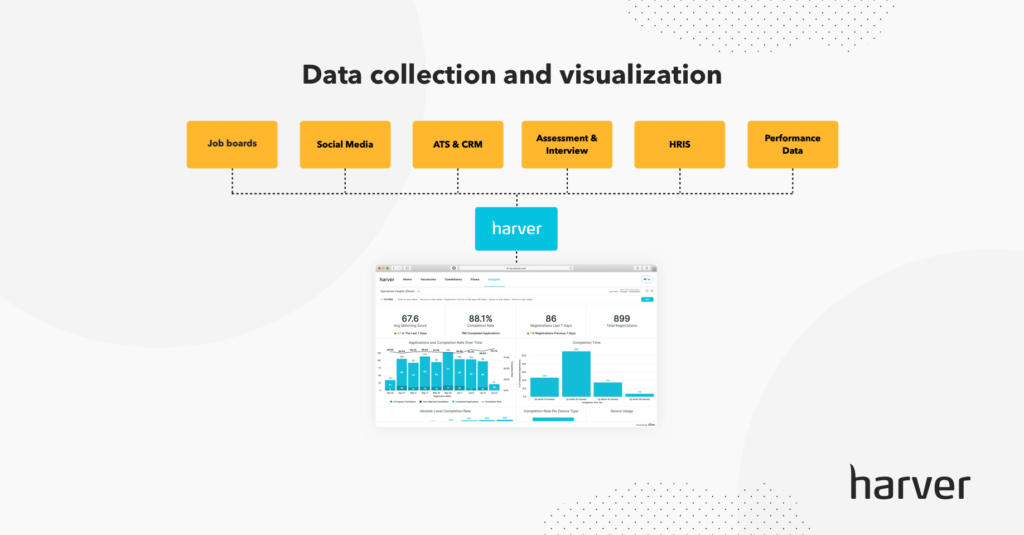
To streamline the process and speed up your volume hiring, you want to identify any points of friction within your existing recruitment funnel, as well as any data your talent acquisition team don’t have oversight of yet.
Most tech tools are able to report on the data they capture, however in order to make data-driven hiring decisions, at speed, you want to bring all of your data into one place – into one single source of truth.
If you’d like to see how Haver can transform your hiring process,
book a demo here!
How to streamline the hiring process for speed
With all prerequisites in place, you should be ready to automate the process and streamline it, to speed up hiring.
Pre-employment assessments
When you’re assessing applicants, you need to use automated pre-employment assessments that are specifically designed to handle volume hiring.
These role-specific assessments will identify candidates who possess the most important characteristics of customer service to be a top performer in your BPO.
For hourly roles in BPOs, skills matter more than experience. Past experience is not a predictor of future performance – in fact, 78% of applicants lie about their past experience. And even if they did tell the truth, just because they’ve done the role before, doesn’t mean they’re any good at it.
To truly speed up your hiring, your entire BPO volume hiring process could be simplified to assess only for the skills needed for top performers. With Harver, for example, the screening and assessment flow can be minimized, as recruiters can just use the live chat support simulation module to assess applicants.
Experience our best-in-class Live Chat Assessment first-hand!
Perfect for remote hiring, our live chat assessment makes it easier than ever to hire live chat agents. Candidates experience the job, while you get actionable data to drive hiring decisions.
Create a bespoke candidate selection flow
To hire great candidates at scale, quickly, requires a bespoke candidate selection flow that accurately reflects the specific requirements of your open roles, along with your company culture.
Designing your own candidate selection flow also allows you to adapt the process to fluctuating markets. Rather than screening out applicants who don’t pass certain filters, your bespoke candidate selection flow will use your assessments to match candidates to more suitable roles. In a tight labor market, using the available talent to fill your open positions doesn’t just make sense, it saves time too.
Your candidate selection flow should let the candidate decide for themselves if the role is suitable for them. By including realistic job previews and situational judgment tests in the selection flow, you’ll not only be able to accurately assess applicants in a real life scenario, you’re also giving them insight into the job, while providing an engaging interactive experience.
Note: In the Harver platform, a candidate selection flow for your BPO might look something like: employer video, personal information, work availability, system diagnostics, language proficiency, live chat support simulation, situational judgment test, personality questionnaire, live interview.

Automate the application process
We’re currently operating in a tight labor market, meaning talent is scarce, but there are a lot of companies hiring. You need to act fast to secure applicants. Automation is the key here, as it allows you to move candidates through the recruitment process fast and efficiently, offering the top talent job security, quickly.
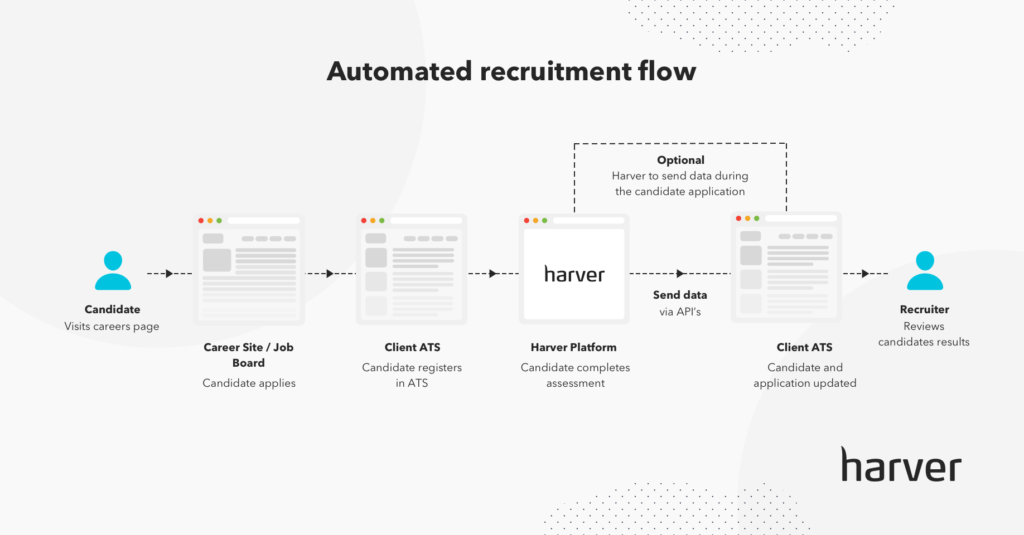
Automating the hiring process can put applicant screening, assessment and selection on autopilot, freeing up recruiters and ensuring that only the most suitable applicants – i.e. qualified candidates who meet your benchmarks and who are a cultural fit, make it through to the interview stage.
Next steps
At Harver, we help global contact centers and BPOs redesign their recruitment strategy to reduce their time to hire and speed up their hiring process without losing quality of hire, making their volume hiring more effective, easier to scale, and future-proof.
If you’d like to see our BPO solution in practice, you can book a demo below.
Ready to transform your hiring process?
